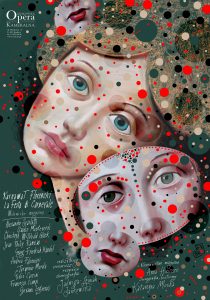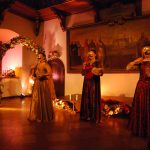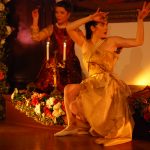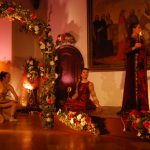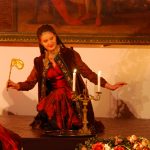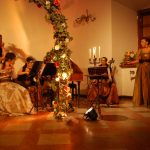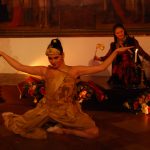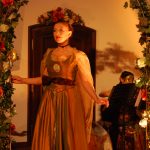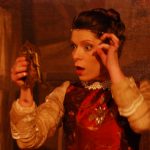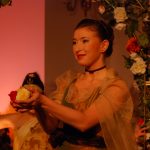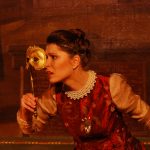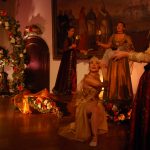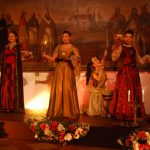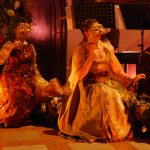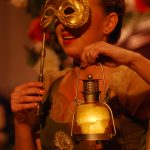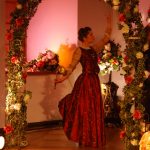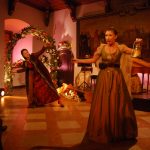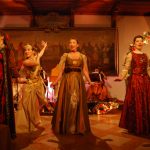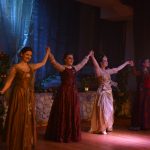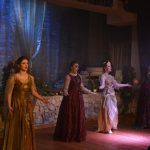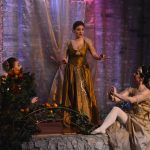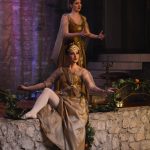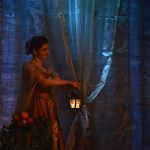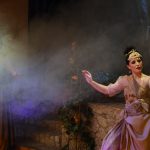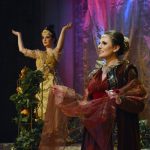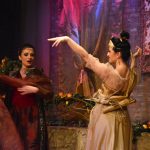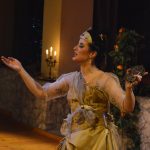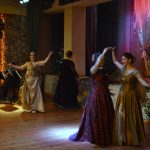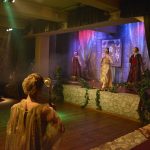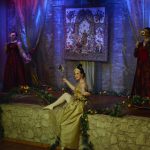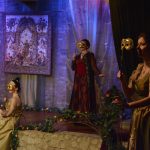Credits
World premiere, Royal Castle in Niepołomice, November 23, 2007
Screenplay, direction, choreography – Jadwiga Leśniak-Jankowska
Set design, costumes – Katarzyna Mucha
Director’s assistant – Magdalena Kajrowicz
Flower arrangement of the scene – Agnieszka Bogusz
Fabrication of masks – Ryszard Hodur
Diana, goddess of hunting: Magdalena Kajrowicz
Muses:
Adrianna Bujak (soprano)
Anna Krawczyk (soprano)
Liliana Pociecha (soprano)
The Old Instruments Group of the Krakow Chamber Opera:
Flute traverso – Monika Czyżewska
Baroque violin – Marta Salwarowska
Viola da gamba – Anna Szelińska-Mikus
Spinet – Anna Huszczo
Carnival gala, February 6, 2016
Direction, screenplan, choreography – Jadwiga Leśniak – Jankowska
Musical direction – Anna Huszczo
Scenography, costumes – Katarzyna Mucha
Fabrication of masks – Ryszard Hodur
Diana, goddess of hunting – Anna Bugajska
Muses
Sylwia Frączek (soprano)
Sylwia Olszyńska (soprano)
Wiktoria Zawistowska (mezzosoprano)
The Krakow Chamber Opera Orchestra:
Violin – Barbara Szpakiewicz
Cello – Ewa Wojsław – Bober
Flute – Ewa Tupik
Spinet – Anna Huszczo
Photos
World premiere, Royal Castle in Niepołomice, November 23, 2007
Fot. Paweł Zechenter
Carnival gala, February 6, 2016
Fot. Paweł Zechenter
Reviews
From the opera house
An evening with opera, spent in a modest interior managed by Jadwiga and Wacław Jankowski on Miodowa Street. I must admit that when the Chamber Opera was being established I did not believe in the success of this endeavour. I underestimated the sheer passion of its founders. The subsequent productions have proven not only the validity of their decision, but also the vital role this scene plays – it is making the citizens of Krakow more musically aware while also showcasing young artists.
‘La Festa di Carnevale’, which has been staged on Saturday, turned out to be a slightly dramatized concert of renaissance and baroque canzonas and arias. Period dancing has been incorporated into the show, and fragments of a medieval love poem recited by Magdalena Kajrowicz interspersed the spectacle. Three singers: Adrianna Bujak, Anna Krawczyk and Liliana Pociecha were accompanied by the chamber music ensemble. The singers’ pretty costumes were the work of Katarzyna Mucha, while Agnieszka Bogusz was responsible for the flower decorations. The unpretentious spectacle – a mix of theatrical play and concert – was met with great enthusiasm from the audience. It brought the world of remote cultural and aesthetical conventions a bit closer while its music soothed our ears.
Anna Woźniakowska
Dziennik Polski, 5th February 2008
* * * * * * * *
Donuts and women
An interview with Jadwiga Leśniak-Jankowska, director and script writer of the carnival Opera Gala ‘La Festa di Carnevale’
– What is the story behind the title ‘La Festa di Carnevale’?
– The premiere of a spectacle, which is an opera gala organised by the Krakow Chamber Opera to coincide with the ending of the carnival period. To put it in different terms, it’s Mardi Gras in our opera house – a historical celebration, with repertoire of early Baroque and late Renaissance music. We’d like to pay our homage to the courtly traditions of this period.
– There will be traditional Polish donuts and angel wings served as a treat during the interval.
– Yes, that is because the spectacles will be staged during the last carnival weekend. According to the Mardi Gras tradition of unrestrained joy and feasting we offer our viewers a poetic stageplay full of excellent music by, among others, Monteverdi, Glück, Händel and Merula. We also offer traditional Polish Mardi Gras confectionery – donuts (‘pączki’) and angel wings (‘chrust’).
– What were the criteria for choosing the pieces which comprise the repertoire of the Carnival Gala?
– The most important aspect to consider was the mood of a musical piece. The compositions which will be played during the gala have to be positive and joyful. The other factor has been the lyrical content of a musical piece, its main message. I did not restrict myself to the sung works – there are quite a few instrumental pieces in there as well. I was also inspired by the late medieval French poetry.
– That would be ‘Roman de la Rose’ by Guillaume de Lorris and Jean de Meun, wouldn’t it?
– Indeed. It tells the story of a young man who has found himself in a rose garden of Love. He wants to pick a rose, but it is guarded by the allegorical personages in the form of beautiful women.
– In the spectacle there are mythological characters as well: goddess Diana and three Muses.
– It is due to the fact that in the past all the carnival festivities derived their elements from ancient mythologies. To fill in the time between all those dances and celebrations the courtiers were preparing stageplays in which they acted themselves. The heroes of those theatrical stories were mythological characters. The ladies of Olympus will also show up in our production.
Diana, the goddess of hunt, but also forests, mountains and moon, will lead u sinto the Garden of Love, while the three Muses (three sopranos) – goddesses of song, dance and music – are going to perform old Italian love arias and canzonas.
– There will be some dances as well.
– Of course, but those would be the historical, courtly dances. There will also be pantomime scenes arranged by Ryszar Hodur. The scene, as it befits the rose garden of love, shall be decorated with flowers by our florist Agnieszka Bogusz.
– That would be another love story.
– Normally the carnival love was exuberant. In our spectacle, both in sung and recited parts, we can fin an encouragement to love one another. However, the Muses warn us that the unfaithful shall be punished. One must learn the art of seduction, but only to find his or her counterpart and stay true to that person.
– Where have you searched for lyrics to this spectacle?
– In the libraries and archives. There are numerous sources, so there was a lot material to choose from. This time it was really difficult for me to trim down the source texts and choose the right ones. For the sake of the script and playwriting I had to discard many beutiful pieces. I created a spectacle which reconstructs the old, courtly carnival festivities.
– And how did people amuse themselves at courts in the past?
– In contrast to the ludic, common carnivale celebrations a more refined amusement was being practiced. It connected the elements of a social gathering, theatre and ballet, while allegorical play took the place of a farce.
Interviewer: Agnieszka Malatyńska-Stankiewicz
Dziennik Polski, 31st January 2008

